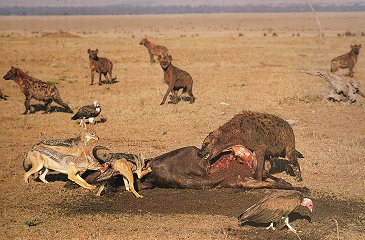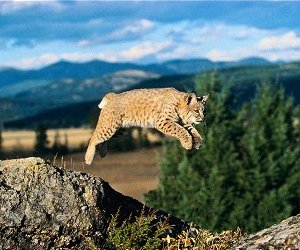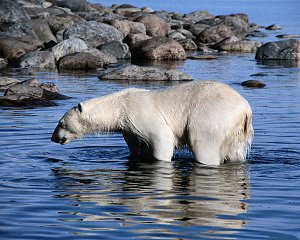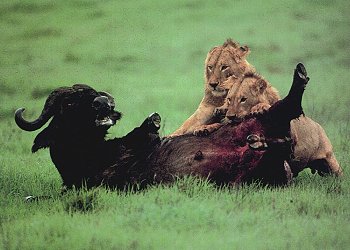THE ORDER CARNIVORA
Carnivora – Meat Eating Mammals (About 230 species.)
Just as rodents identify themselves by their long incisors, members of the order Carnivora are distinguished by their prominent canine teeth. These are the long, curved, teeth beside the incisors that are particularly effective for stabbing. Most carnivores are predatory meat-eaters with small but sharp incisors, good for nipping, but other larger carnivores have long teeth for killing, such as the big cats.

A special adaptive feature lies in the fourth upper premolar and the first lower molar, specialized teeth that form shearing blades to cut up meat guillotine fashion. These cutting teeth, called carnassials, are common to meat-eating Carnivores who kill large prey. They shear off small chunks of meat and swallow it whole, rather than chewing it. Many cats have a rasp-rough tongue that can literally lick the meat off of bones. Carnassials are least developed in those species whose diets have become less carnivorous, and the aquatic members of the order lack carnassials, either swallowing the prey whole or ripping it into smaller parts.
The carnivores have strong jaws, powerful muscles, and heavy skulls to put their teeth into action. Among the strongest jaws are the Jaguar of South America, which can bite through a turtle’s shell, and the hyena of Africa, which can bite through bones to get to the bone marrow inside.

Carnivores are an ancient order, having evolved from early Paleocene creodonts, and have spread successfully to all parts of the world, including the Arctic and Antarctic, but are not native as land-dwellers to Australia, New Zealand, or many oceanic islands. (The dingo is a domestic dog introduced into Australia by an aboriginal man, and the fox was introduced by later inhabitants of Australia.)
The Carnivores have become widely diversified; some species are nocturnal in habit, while others are active during the day (diurnal), and many are active both day and night.
There are 239 terrestrial and semiaquatic species of so-called fissiped (separated toes) carnivores, whereas the truly aquatic forms (34 species) make up three families of pinniped (feather, or fin-footed) carnivores. The most familiar family of fissipeds is the Canida – dogs, jackals, wolves, and foxes – found in a variety of habitats from the Arctic to the tropics. They are highly predatory and often hunt over great distances, being endowed with either great speed, as in the coyote, or endurance, as in wolves. Some canids hunt in packs; many eat carrion, fruit, and other plant material, or almost any edible matter available.

Closely related to the dog family are bears, or Ursidae, which are the largest living terrestrial carnivores. Although there are tropical species, for the most part, bears inhabit cold northern regions. In temperate climates, they may take refuge in caves but do not actually hibernate. Bears have become omnivorous and lost the shearing capacity of their carnassials, but the polar bear is still a meat-eater. The giant panda, included in the bear family, has a unique diet of bamboo and is therefore not literally a Carnivore, yet is still classified as such.
Raccoons and their kin are medium-sized carnivores, also related to canids, and are New World species except for the lesser panda of Asia. The procyonids, as they are called, are omnivorous and arboreal. Their carnassials are modified for crushing.
Mustelids are small animals with short legs and long bodies and have well-developed scent glands. This family includes weasels, badgers, skunks, and otters and has a wide distribution in all climates, in both the Old and New Worlds. They seek out and prey upon various vertebrate animals smaller than themselves, such as rodents, and are known to eat insects as well.
Similar to the mustelids in general appearance is a family of carnivores found in Africa and southern Eurasia, the Viverridae. They are the civets and genets. Like mustelids, viverrids have strong scent glands and feed upon smaller animals. They do not tolerate cold climates, however, and again unlike mustelids, they have retractile or semiretractile claws.

Mongooses, the Herpestidae, was until recently placed in the Viverridae, but their distinctness has recently become more convincing.
The hyenas of Africa and southern Asia constitute a separate family. These strong, heavy animals are dog-sized, have longer forelegs than hind, nonretractile claws, and well-developed carnassials. They are predatory and also feed on carrion.
The aardwolf, in a family by itself, and prefers a diet of ants, termites, and insect larvae.
The well-known felids, or cat family, range worldwide except in Australia, Antarctica, and certain islands. They are the elite of predators, with strong limbs and sharp, curved, retractile claws, able to stalk, run-down, and kill prey of their own size or very much larger. The cheetah’s claws are only semiretractile.
The seals, sea lions, and walrus, known as the pinnipeds, are highly aquatic carnivores, found along nearly all coastal regions of the world, including the Arctic and Antarctic. Their bodies are streamlined and their limbs are modified for swimming, but unlike cetaceans, they have kept their hind limbs. They breed and give birth on land. In fact, some species spend considerable time ashore. All are carnivorous, the diets varying from fish to marine invertebrates, birds, or even other seals. Most pinnipeds are active during the day, and some are highly gregarious.
Check out the following specific carnivores included:
Coyote
Gray Wolf
Dingo
Golden Jackal
Simian Jackal
Arctic Fox
Kit Fox
Red Fox
Gray Fox
Fennec
Raccoon-dog
Paraguayan Fox
Dhole
Maned Wolf
Cape Hunting Dog
Bush Dog
African Fox
Spectacled Bear
Asiatic Black Bear
Brown Bear
American Black Bear
Sun Bear
Polar Bear
Sloth Bear
Ringtailed Cat
Raccoon
Coati
Kingkajou
Lesser Panda
Giant Panda
Fisher
Pine Marten
Ermine
Long-Tailed Weasel
Common Weasel
Tayra
Grison
Wolverine
Polecat
Honey Badger
Old World Badger
Hog Badger
American Badger
Striped Skunk
Spotted Skunk
Eurasian Otter
Giant Otter
African Otter
Genet
African Civet
Indian Civet
Linsang
Palm Civet
Binturong
Fossa
Fanaloka
Meerkat
Egyptian Mongoose
Dwarf Mongoose
Yellow Mongoose
Aardwolf
Spotted Hyena
Striped Hyena
Lynx
Caracal
Bobcat
Manul
Serval
European Wild Cat
Puma
Ocelot
Leopard Cat
Jaguarundi
Jaguar
Lion
Tiger
Leopard
Clouded Leopard
Snow Leopard
Cheetah
Fur Seal
Steller Sea Lion
California Sea Lion
Walrus
Harbor Seal
Harp Seal
Gray Seal
Bearded Seal
Monk Seal
Hooded Seal
Elephant Seal
Crabeater Seal
Leopard Seal
Weddell Seal
